英语的八种主要时态的结构及口诀
8大时态的基本结构

8大时态的基本结构一、一般现在时(Simple Present Tense)一般现在时用来描述经常性或习惯性的动作、真理、客观事实或现状。
在英语中,一般现在时的基本结构为:主语 + 动词原形(第三人称单数要加-s)+ 其他。
例如:1. Cats like to play with balls.猫喜欢玩球。
2. The sun rises in the east.太阳从东方升起。
二、一般过去时(Simple Past Tense)一般过去时用来描述过去发生的动作或存在的状态。
在英语中,一般过去时的基本结构为:主语 + 动词过去式 + 其他。
例如:1. I watched a movie last night.昨晚我看了一部电影。
2. She lived in London for five years.她在伦敦生活了五年。
三、一般将来时(Simple Future Tense)一般将来时用来描述将来要发生的动作或存在的状态。
在英语中,一般将来时的基本结构为:主语 + will + 动词原形 + 其他。
例如:1. We will visit our grandparents next week.下周我们将去拜访我们的祖父母。
2. He will be a doctor in the future.他将来会成为一名医生。
四、现在进行时(Present Continuous Tense)现在进行时用来描述正在进行的动作。
在英语中,现在进行时的基本结构为:主语 + am/is/are + 动词-ing + 其他。
例如:1. They are playing basketball in the park.他们正在公园里打篮球。
2. She is studying for her exam now.她现在正在为考试而学习。
五、过去进行时(Past Continuous Tense)过去进行时用来描述过去某个时间正在进行的动作。
英语八大时态结构_含例句
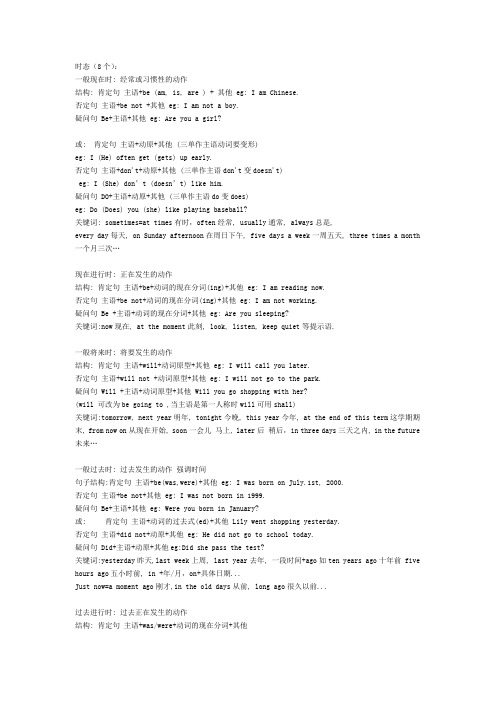
时态(8个):一般现在时: 经常或习惯性的动作结构: 肯定句主语+be (am, is, are ) + 其他 eg: I am Chinese.否定句主语+be not +其他 eg: I am not a boy.疑问句 Be+主语+其他 eg: Are you a girl?或: 肯定句主语+动原+其他 (三单作主语动词要变形)eg: I (He) often get (gets) up early.否定句主语+don't+动原+其他 (三单作主语don't变doesn't)eg: I (She) don’t (doesn’t) like him.疑问句 DO+主语+动原+其他 (三单作主语do变does)eg: Do (Does) you (she) like playing baseball?关键词: sometimes=at times有时,often经常, usually通常, always总是,every day每天, on Sunday afternoon在周日下午, five days a week一周五天, three times a month 一个月三次…现在进行时: 正在发生的动作结构: 肯定句主语+be+动词的现在分词(ing)+其他 eg: I am reading now.否定句主语+be not+动词的现在分词(ing)+其他 eg: I am not working.疑问句 Be +主语+动词的现在分词+其他 eg: Are you sleeping?关键词:now现在, at the moment此刻, look, listen, keep quiet等提示语.一般将来时: 将要发生的动作结构: 肯定句主语+will+动词原型+其他 eg: I will call you later.否定句主语+will not +动词原型+其他 eg: I will not go to the park.疑问句 Will +主语+动词原型+其他 Will you go shopping with her?(will 可改为be going to ,当主语是第一人称时will可用shall)关键词:tomorrow, next year明年, tonight今晚, this year今年, at the end of this term这学期期末, from now on从现在开始, soon一会儿马上, later后稍后,in three days三天之内, in the future 未来…一般过去时: 过去发生的动作强调时间句子结构:肯定句主语+be(was,were)+其他 eg: I was born on July.1st, 2000.否定句主语+be not+其他 eg: I was not born in 1999.疑问句 Be+主语+其他 eg: Were you born in January?或: 肯定句主语+动词的过去式(ed)+其他 Lily went shopping yesterday.否定句主语+did not+动原+其他 eg: He did not go to school today.疑问句 Did+主语+动原+其他eg:Did she pass the test?关键词:yesterday昨天,last week上周, last year去年, 一段时间+ago如ten years ago十年前 five hours ago五小时前, in +年/月,on+具体日期...Just now=a moment ago刚才,in the old days从前, long ago很久以前...过去进行时: 过去正在发生的动作结构: 肯定句主语+was/were+动词的现在分词+其他eg: I was doing my homework at 8 o’clock yesterday evening.否定句主语+was/were not +动词的现在分词+其他They were not staying at home at this moment last Sunday.疑问句 Was/Were + 主语+ 动词的现在分词+其他Were you sleeping when I called you last night?关键词:具体时间如:at ten o'clock yesterday morning, at this moment last Sunday上周日的这个时候...现在完成时: 过去发生的动作对现在造成的影响强调动作或其产生的结果结构:肯定句主语+have/has+动词的过去分词+其他(三单变成has)eg: This year alone, we've already planted ten thousand trees否定句主语+have/has not+动词的过去分词+其他eg: He has not arrived at home yet.疑问句 Have/Has +主语+动词的过去分词+其他eg: Have you been to China?关键词:already已经, yet还, just刚刚, ever曾经, never从不,so far目前, for +一段时间,since+过去的具体时间,this year alone今年以来,these five years alone这五年以来",in the last ten years 在过去的十年中…过去将来时:结构: 肯定句主语+ would+动原+其他 eg: I didn't know if he would come.否定句主语+ would not +动原+其他eg: They were not going to go hiking unless they finished their homework.疑问句 Would+主语+动词原型+其他 (would you like是词组一个固定搭配一般用表示礼貌的问)eg: Would you like to have a dinner with me?(would可改为was/were going to ,主语第一人称时would也可以用should)过去完成时:结构: 肯定句主语+had +动词的过去分词+其他eg: Mr. Smith died yesterday. He had been a good friend of mine.否定句主语+had not +动词的过去分词+其他eg: He said he has not been to America.疑问句 Had+主语+动词的过去分词+其他eg: Had he completed his homework by the time you got there.关键词: 句子中的两个动作都发生在过去一、一般现在时:概念:经常、反复发生的动作或行为及现在的某种状况。
英语时态顺口溜 整理版

英语时态顺口溜◆一般现在时:◆现在经常做的事,要用一般现在时。
◆第三人称作主语,动词后面加s/es。
◆其它人称作主语,动词只需用原形。
◆若是变成否定句,没be动词前面加个do,◆碰到三单加does,not 加be do does 后◆若是变成疑问句,把be提前就可以。
◆没be 句首就加do\does,◆一般将来时:不久将要发生的事,记住要用将来时。
be加going to,后面跟着动原形,be的形式要记住,随着主语及时变。
还有一种表达法, will后面加动原形。
will不一般,will后要加动原。
要一般变疑问句, will要置主语前。
否定句也不难, will后要把not添。
◆现在进行时:现在正在做的事,要用现在进行时。
它的构成很简单, be后动词缀上ing。
词尾若有哑音e,去e再加没问题。
一辅重读闭音节,这个字母要双写。
be的形式有三变,就是am、is、are。
要用哪一个,看谁作主语。
一般过去时:事情已发生,要用过去时,动词拖个尾巴叫ed。
主语在句首,后面跟着动词过去式。
不要不要否定式,didn’t插队动词前,动词吓得变原形。
有人问起怎么办, Did插队主语前,动词又得变原形。
Be不Be不真胆大,不用愁来不用怕,问问你们怎么办, BeBe前头不用怕。
一般过去式歌过去式构成有方法,一般词尾加ed。
如果词尾有个e,直接加d就可以。
辅音字母y在尾,变y为i加ed。
“一辅重闭”作尾巴,双写之后ed加。
标准过去式加ed,少量不规则分别记。
am,is对was, are变were没问题。
have,has用had, do和does变did。
现在完成时已经完成事,现在完成时人称加have,动词过去分词紧跟后。
人称若是三单式,have要用has替。
否定句很简单,have(has)后面加not,疑问句也不难,have(has)提前就可以。
现在完成时,have, has加ed过去某时已发生,后果影响记心中,过去某时已发生,持续现在还发生。
英语的八种主要时态的结构及口诀

英语的八种主要时态的结构一、一般现在时:概念:经常、反复发生的动作或行为及现在的某种状况。
例:He listens to the radio every evening.时间状语:always, usually, often, sometimes, every week (day, year, month…), once a week , onSunday, etc.基本结构:①be动词;②行为动词否定形式:①am/is/are +not;②此时态的谓语动词若为行为动词,则在其前加don't,如主语为第三人称单数,则用doesn't,同时还原行为动词。
一般疑问句:①把be动词放于句首;②用助动词do提问,如主语为第三人称单数,则用does,同时,还原行为动词。
二、一般过去时:概念:过去某个时间里发生的动作或状态;过去习惯性、经常性的动作、行为。
例:I was born on April 2, 1986.时间状语:ago, yesterday, the day before yesterday, last week(year, night, month…), in 1 989, just now, at the age of 5, one day, once upon a time, etc.基本结构:①be动词;②行为动词否定形式:①was/were +not;②在行为动词前加didn't,同时还原行为动词。
一般疑问句:①was或were放于句首;②用助动词do的过去式did 提问,同时还原行为动词。
三、现在进行时:概念:表示现阶段或说话时正在进行的动作及行为。
例:The woman is talking to the doctor.时间状语:now, at this time, these days, etc.基本结构:am /is/are +doing否定形式:am /is/are +not +doing.一般疑问句:把be动词放于句首。
英语语法记忆口诀
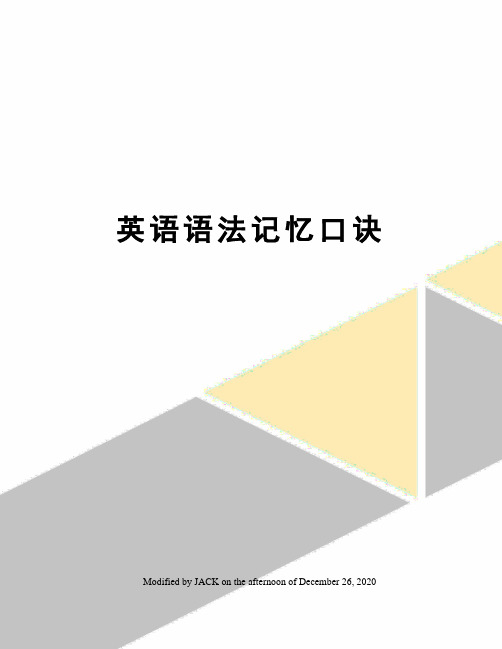
英语语法记忆口诀 Modified by JACK on the afternoon of December 26, 2020英语语法记忆口诀1、一般现在时一般现在时态中,动词一般用原形。
表述事实讲真理,习惯动作常发生。
动词词尾加-s(es),只表单数三人称。
若变一般疑问句,得看句型是哪种。
系表结构和there be, be放句首可完成;若遇实义动词句,do或does莫忘用!2、现在进行时Look, Listen是标志,现在进行正发生;有时now在句中现,“be+v-ing”时态成。
若问be用何形式,须看主语数、人称。
He / She is, I am. We, you, they后are紧跟。
v-ing形式更好记,三种构成要分清。
一般问句be提前,be后加not否定成!3、基数词变序数词基变序,很容易,一二三,特殊记,th从四起。
八去t来九去e,遇到ve,f 替,ty变为tie,后加th莫迟疑,若想表示几十几,只变个位就可以。
时间介词巧记歌年、月、季节前须用in,(如:in 2008, in September, in spring)日期前面行不通。
遇到几号改用on,(如:on January 1)上午、下午、晚上仍用in。
(如:in the morning/afternoon/evening) 若是某日上下午,也是用on才能行。
(如:on the evening of the Mid-autumn Day)正午、夜里用at,(如:at noon, at night)时、分用法也同理。
(如:, at two, at two)如若“差”点须加to,(如:two to two)如若“过”点改past。
(如:half past one)多说勤练牢牢记,学好英语非儿戏。
4、谓语be的用法我用am,你用are除此之外的单数包括他她还有它统统都是用is我们你们和他们只要复数都用are5、一般疑问句和否定句的变化一般问句并不难,谓语调到主语前。
英语八种时态的结构
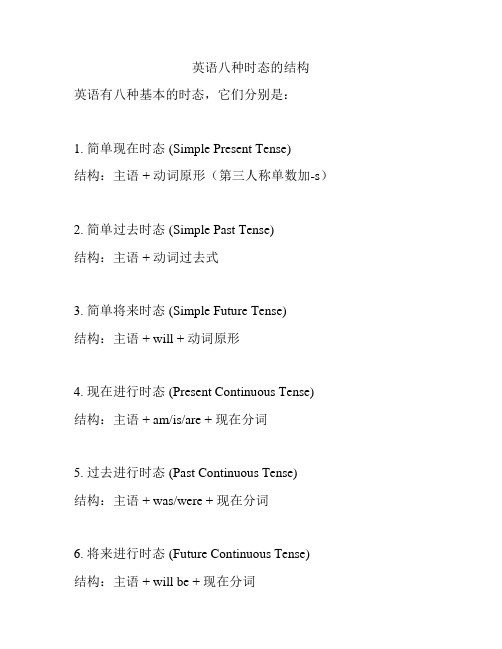
英语八种时态的结构
英语有八种基本的时态,它们分别是:
1. 简单现在时态 (Simple Present Tense)
结构:主语 + 动词原形(第三人称单数加-s)
2. 简单过去时态 (Simple Past Tense)
结构:主语 + 动词过去式
3. 简单将来时态 (Simple Future Tense)
结构:主语 + will + 动词原形
4. 现在进行时态 (Present Continuous Tense)
结构:主语 + am/is/are + 现在分词
5. 过去进行时态 (Past Continuous Tense)
结构:主语 + was/were + 现在分词
6. 将来进行时态 (Future Continuous Tense)
结构:主语 + will be + 现在分词
7. 现在完成时态 (Present Perfect Tense)
结构:主语 + have/has + 过去分词
8. 过去完成时态 (Past Perfect Tense)
结构:主语 + had + 过去分词
除了这些基本时态,还有一些其他时态的变体,如进行完成时态 (Present Perfect Continuous Tense) 和将来完成时态 (Future Perfect Tense)。
八大时态的基本结构

八大时态的基本结构八大时态是指英语中的基本时态,包括简单现在时、一般过去时、一般将来时、现在进行时、过去进行时、现在完成时、过去完成时和将来完成时。
下面将对每个时态的基本结构进行详细说明。
1.简单现在时简单现在时主要用来描述经常发生的动作、事实、常规情况以及普遍真理。
它的基本结构为:主语 + 动词原形(第三人称单数需在动词末尾加-s/-es)+ 其他成分For example:- I play basketball every day.- He watches TV every night.- They speak English fluently.2.一般过去时一般过去时用来表示已经结束的动作或状态。
它的基本结构为:主语+动词过去式+其他成分For example:- I played basketball yesterday.- He watched a movie last night.- They spoke to their teacher this morning.3.一般将来时一般将来时用来表示将来发生的动作或情况。
它的基本结构为:主语 + will + 动词原形 + 其他成分For example:- I will play basketball tomorrow.- He will watch a movie later.- They will speak to their teacher next week.4.现在进行时现在进行时用来表示正在进行的动作。
它的基本结构为:主语 + am/is/are + 动词-ing形式 + 其他成分For example:- I am playing basketball right now.- He is watching a movie at the moment.- They are speaking to their teacher currently.5.过去进行时过去进行时用来表示在过去其中一时刻正在进行的动作。
初中英语语法动词八种时态详解
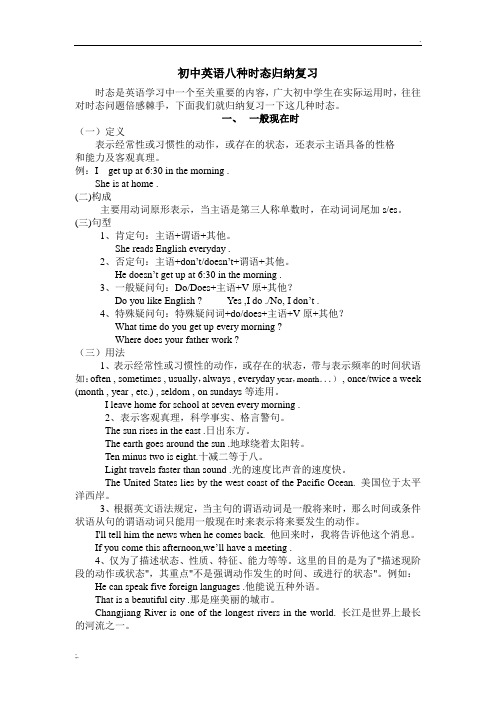
初中英语八种时态归纳复习时态是英语学习中一个至关重要的内容,广大初中学生在实际运用时,往往对时态问题倍感棘手,下面我们就归纳复习一下这几种时态。
一、一般现在时(一)定义表示经常性或习惯性的动作,或存在的状态,还表示主语具备的性格和能力及客观真理。
例:I get up at 6:30 in the morning .She is at home .(二)构成主要用动词原形表示,当主语是第三人称单数时,在动词词尾加s/es。
(三)句型1、肯定句:主语+谓语+其他。
She reads English everyday .2、否定句:主语+don’t/doesn’t+谓语+其他。
He doesn’t get up at 6:30 in the morning .3、一般疑问句:Do/Does+主语+V原+其他?Do you like English ? Yes ,I do ./No, I don’t .4、特殊疑问句:特殊疑问词+do/does+主语+V原+其他?What time do you get up every morning ?Where does your father work ?(三)用法1、表示经常性或习惯性的动作,或存在的状态,带与表示频率的时间状语如:often , sometimes , usually,always , everyday year,month...), once/twice a week (month , year , etc.) , seldom , on sundays等连用。
I leave home for school at seven every morning .2、表示客观真理,科学事实、格言警句。
The sun rises in the east .日出东方。
The earth goes around the sun .地球绕着太阳转。
Ten minus two is eight.十减二等于八。
英语时态公式口诀

英语时态公式口诀时态是英语语法中的重要部分,掌握好时态对于提高英语水平和写作能力都非常重要。
以下是英语时态的公式口诀,帮助你更好地理解和记忆时态。
一、一般现在时一般现在时态的基本用法口诀为:一般现在时,动词很简单。
看见be动词,就找主语换。
有他be动词,也有没他be动词,看见他动词,后面跟着他朋友。
二、现在进行时现在进行时态的基本用法口诀为:现在进行时,正在进行时。
be动词加动词ing,be动词加动词ing,我们唱起歌来庆祝。
唱歌要分音节拍,拍拍拍打拍拍拍。
唱歌要把主语表,动词要把ing跟。
其他单词后面跟,请你一定要记住。
三、一般将来时一般将来时态的基本用法口诀为:一般将来时态结构记,be going to要牢记。
will+动词原形记清楚,将来时态很简单。
四、一般过去时一般过去时态的基本用法口诀为:一般过去时态式,过去式词尾有-d(e) (过去式)。
词尾若是辅音字母+y (过去式要改y为i),后面再加-ed(过去式)。
结尾若有S或es,前面再加-d(ed)。
如two→twice (两倍) 。
五、现在完成时现在完成时态的基本用法口诀为:have(has)加过去分词,have been是助动词,have has后跟过去分词,have been后跟表语形容词。
六、过去完成时过去完成时态的基本用法口诀为:过去完成时很难懂,过去完成动作时再加过去某个时间作宾语的话就用过去完成时。
要注意完成时有两个别号分别叫:had done和would have done 。
七、过去进行时过去进行时态的基本用法口诀为:过去进行正进行,一般将来时的动作,一分为二两段成。
was/were+V-ing将来进行时会发生。
was/were+V-ing过去将来时不会错。
过去将来时常可表。
was/were+V-ing一过时间就要用。
was/were+V-ing用过之后才发生。
was/were+V-ing过完时间仍可用。
八、被动语态被动语态的基本用法口诀为:被动语态并不难,主动变被动记心间。
英语八大时态结构_含例句

时态(8个):一般现在时: 经常或习惯性的动作结构: 肯定句主语+be (am, is, are ) + 其他 eg: I am Chinese.否定句主语+be not +其他 eg: I am not a boy.疑问句 Be+主语+其他 eg: Are you a girl?或: 肯定句主语+动原+其他 (三单作主语动词要变形)eg: I (He) often get (gets) up early.否定句主语+don't+动原+其他 (三单作主语don't变doesn't)eg: I (She) don’t (doesn’t) like him.疑问句 DO+主语+动原+其他 (三单作主语do变does)eg: Do (Does) you (she) like playing baseball?关键词: sometimes=at times有时,often经常, usually通常, always总是,every day每天, on Sunday afternoon在周日下午, five days a week一周五天, three times a month 一个月三次…现在进行时: 正在发生的动作结构: 肯定句主语+be+动词的现在分词(ing)+其他 eg: I am reading now.否定句主语+be not+动词的现在分词(ing)+其他 eg: I am not working.疑问句 Be +主语+动词的现在分词+其他 eg: Are you sleeping?关键词:now现在, at the moment此刻, look, listen, keep quiet等提示语.一般将来时: 将要发生的动作结构: 肯定句主语+will+动词原型+其他 eg: I will call you later.否定句主语+will not +动词原型+其他 eg: I will not go to the park.疑问句 Will +主语+动词原型+其他 Will you go shopping with her?(will 可改为be going to ,当主语是第一人称时will可用shall)关键词:tomorrow, next year明年, tonight今晚, this year今年, at the end of this term这学期期末, from now on从现在开始, soon一会儿马上, later后稍后,in three days三天之内, in the future 未来…一般过去时: 过去发生的动作强调时间句子结构:肯定句主语+be(was,were)+其他 eg: I was born on July.1st, 2000.否定句主语+be not+其他 eg: I was not born in 1999.疑问句 Be+主语+其他 eg: Were you born in January?或: 肯定句主语+动词的过去式(ed)+其他 Lily went shopping yesterday.否定句主语+did not+动原+其他 eg: He did not go to school today.疑问句 Did+主语+动原+其他eg:Did she pass the test?关键词:yesterday昨天,last week上周, last year去年, 一段时间+ago如ten years ago十年前 five hours ago五小时前, in +年/月,on+具体日期...Just now=a moment ago刚才,in the old days从前, long ago很久以前...过去进行时: 过去正在发生的动作结构: 肯定句主语+was/were+动词的现在分词+其他eg: I was doing my homework at 8 o’clock yesterday evening.否定句主语+was/were not +动词的现在分词+其他They were not staying at home at this moment last Sunday.疑问句 Was/Were + 主语+ 动词的现在分词+其他Were you sleeping when I called you last night?关键词:具体时间如:at ten o'clock yesterday morning, at this moment last Sunday上周日的这个时候...现在完成时: 过去发生的动作对现在造成的影响强调动作或其产生的结果结构:肯定句主语+have/has+动词的过去分词+其他(三单变成has)eg: This year alone, we've already planted ten thousand trees否定句主语+have/has not+动词的过去分词+其他eg: He has not arrived at home yet.疑问句 Have/Has +主语+动词的过去分词+其他eg: Have you been to China?关键词:already已经, yet还, just刚刚, ever曾经, never从不,so far目前, for +一段时间,since+过去的具体时间,this year alone今年以来,these five years alone这五年以来",in the last ten years 在过去的十年中…过去将来时:结构: 肯定句主语+ would+动原+其他 eg: I didn't know if he would come.否定句主语+ would not +动原+其他eg: They were not going to go hiking unless they finished their homework.疑问句 Would+主语+动词原型+其他 (would you like是词组一个固定搭配一般用表示礼貌的问)eg: Would you like to have a dinner with me?(would可改为was/were going to ,主语第一人称时would也可以用should)过去完成时:结构: 肯定句主语+had +动词的过去分词+其他eg: Mr. Smith died yesterday. He had been a good friend of mine.否定句主语+had not +动词的过去分词+其他eg: He said he has not been to America.疑问句 Had+主语+动词的过去分词+其他eg: Had he completed his homework by the time you got there.关键词: 句子中的两个动作都发生在过去一、一般现在时:概念:经常、反复发生的动作或行为及现在的某种状况。
初中英语必考八大时态结构及用法详解
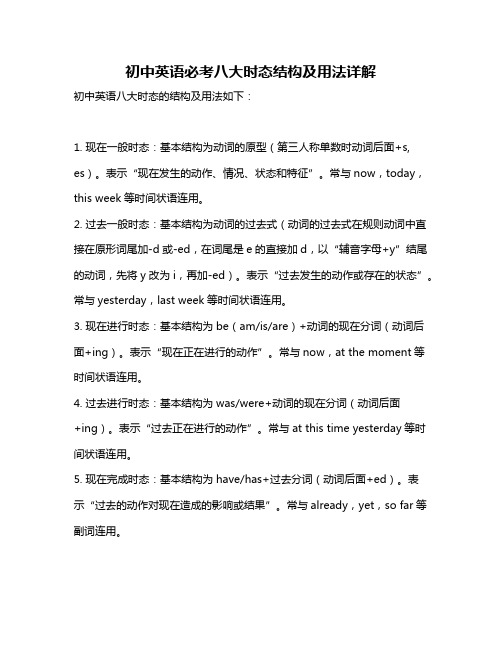
初中英语必考八大时态结构及用法详解初中英语八大时态的结构及用法如下:1. 现在一般时态:基本结构为动词的原型(第三人称单数时动词后面+s, es)。
表示“现在发生的动作、情况、状态和特征”。
常与now,today,this week等时间状语连用。
2. 过去一般时态:基本结构为动词的过去式(动词的过去式在规则动词中直接在原形词尾加-d或-ed,在词尾是e的直接加d,以“辅音字母+y”结尾的动词,先将y改为i,再加-ed)。
表示“过去发生的动作或存在的状态”。
常与yesterday,last week等时间状语连用。
3. 现在进行时态:基本结构为be(am/is/are)+动词的现在分词(动词后面+ing)。
表示“现在正在进行的动作”。
常与now,at the moment等时间状语连用。
4. 过去进行时态:基本结构为was/were+动词的现在分词(动词后面+ing)。
表示“过去正在进行的动作”。
常与at this time yesterday等时间状语连用。
5. 现在完成时态:基本结构为have/has+过去分词(动词后面+ed)。
表示“过去的动作对现在造成的影响或结果”。
常与already,yet,so far等副词连用。
6. 过去完成时态:基本结构为had+过去分词(动词后面+ed)。
表示“过去的动作在过去的某个时间之前已经完成或发生的动作或存在的状态”。
常与by the end of last year,by the time of等时间状语连用。
7. 现在完成进行时态:基本结构为have/has been+动词的现在分词(动词后面+ing)。
表示“动作从过去某时开始,一直延续到现在,或者刚刚完成”。
常与for several days,since等时间状语连用。
8. 过去完成进行时态:基本结构为had been+动词的现在分词(动词后面+ing)。
表示“过去的某个动作从过去某时开始,一直延续到过去的某个时间,或者刚刚完成”。
英语八大时态顺口溜

英语八大时态顺口溜一、一般现在时【口诀】一般现在表经常;时间状语记心上;主从复合不寻常,主将从现不能忘。
【诠释】1.一般现在时表示经常发生的动作或存在的状态;2.常见的时间状语有every day/month/year,often,usually,always等;3.在条件状语从句或时间状语从句中,若主句为将来时态,则从句要用一般现在时表将来。
二、一般过去时【口诀】过去动作常发生,上下文中找情景;标志词语记心中,last、ago最常用。
【诠释】1.一般过去时表示过去发生的动作,多有上下文情景;2.常见的时间状语有last month/year,two/three days ago,yesterday,the day before yesterday等。
三、一般将来时【口诀】一般将来将发生;两种结构要牢记;位移动词特殊性,将来要用be doing。
【诠释】1.一般将来时表示将来某段时间要发生的动作或进行的状态;2.一般将来时有两种结构:一是will+动词原形(否形式为won’t+动词原形);二是be going to+动词原形(多指经过计划或安排之后发生的事情);3.位移动词come,go,leave 等用现在进行时表将来。
四、现在进行时【口诀】现在进行be doing;now、look、listen表正进行;还要兼顾前后的语境。
【诠释】1.现在进行时的结构为be+动词现在分词;2.句中若出现时间状语now 和警示性的提示语look或listen,则要用现在进行时;3.另外,有时需要根据上下文语境判断是否用现在进行时。
五、过去进行时【口诀】过去动作正进行;运用之时有情景;和when,while总是不分离。
【诠释】1.过去进行时表示过去正在发生的动作或存在的状态;2.过去进行时的结构为was/were+doing;3.过去进行时常出现在有上下文情景的句子或when、while引导的时间状语从句中。
六、现在完成时【口诀】过去发生的动作,导致现在的结果;already、ever、never标志多;短暂动词要斟酌,变成延续才正确。
初中英语八种时态归纳
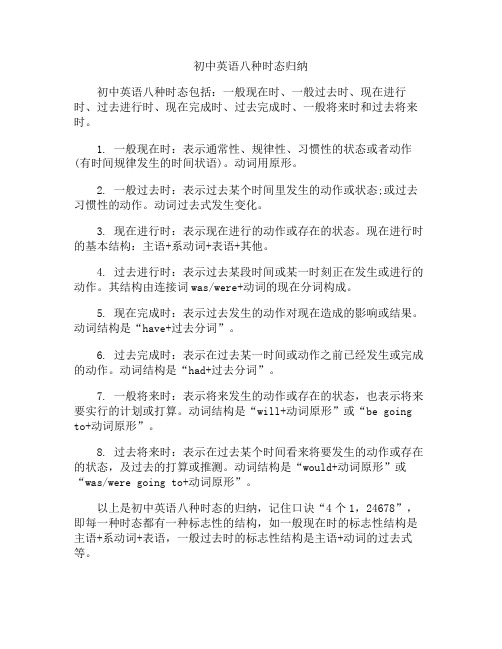
初中英语八种时态归纳
初中英语八种时态包括:一般现在时、一般过去时、现在进行时、过去进行时、现在完成时、过去完成时、一般将来时和过去将来时。
1. 一般现在时:表示通常性、规律性、习惯性的状态或者动作(有时间规律发生的时间状语)。
动词用原形。
2. 一般过去时:表示过去某个时间里发生的动作或状态;或过去习惯性的动作。
动词过去式发生变化。
3. 现在进行时:表示现在进行的动作或存在的状态。
现在进行时的基本结构:主语+系动词+表语+其他。
4. 过去进行时:表示过去某段时间或某一时刻正在发生或进行的动作。
其结构由连接词was/were+动词的现在分词构成。
5. 现在完成时:表示过去发生的动作对现在造成的影响或结果。
动词结构是“have+过去分词”。
6. 过去完成时:表示在过去某一时间或动作之前已经发生或完成的动作。
动词结构是“had+过去分词”。
7. 一般将来时:表示将来发生的动作或存在的状态,也表示将来要实行的计划或打算。
动词结构是“will+动词原形”或“be going to+动词原形”。
8. 过去将来时:表示在过去某个时间看来将要发生的动作或存在的状态,及过去的打算或推测。
动词结构是“would+动词原形”或“was/were going to+动词原形”。
以上是初中英语八种时态的归纳,记住口诀“4个1,24678”,即每一种时态都有一种标志性的结构,如一般现在时的标志性结构是主语+系动词+表语,一般过去时的标志性结构是主语+动词的过去式等。
英语语法八大时态总结 建议收藏
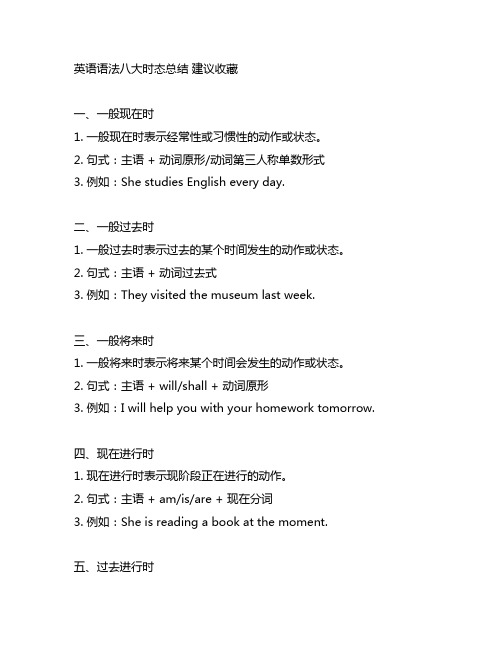
英语语法八大时态总结建议收藏一、一般现在时1. 一般现在时表示经常性或习惯性的动作或状态。
2. 句式:主语 + 动词原形/动词第三人称单数形式3. 例如:She studies English every day.二、一般过去时1. 一般过去时表示过去的某个时间发生的动作或状态。
2. 句式:主语 + 动词过去式3. 例如:They visited the museum last week.三、一般将来时1. 一般将来时表示将来某个时间会发生的动作或状态。
2. 句式:主语 + will/shall + 动词原形3. 例如:I will help you with your homework tomorrow.四、现在进行时1. 现在进行时表示现阶段正在进行的动作。
2. 句式:主语 + am/is/are + 现在分词3. 例如:She is reading a book at the moment.五、过去进行时1. 过去进行时表示过去某一时间正在进行的动作。
2. 句式:主语 + was/were + 现在分词3. 例如:They were playing football when it started to rain.六、现在完成时1. 现在完成时表示过去某个时间开始的动作一直持续到现在或对现在产生影响的动作。
2. 句式:主语 + have/has + 过去分词3. 例如:I have finished my homework.七、过去完成时1. 过去完成时表示在过去某个时间之前已经发生或完成的动作。
2. 句式:主语 + had + 过去分词3. 例如:She had already left when I arrived.八、将来完成时1. 将来完成时表示将来某个时间之前已经发生或完成的动作。
2. 句式:主语 + will/shall + have + 过去分词3. 例如:I will have completed the project by next month.总结回顾英语语法中的八大时态对于学习英语的人来说是十分重要的。
八大时态的结构与用法

八大时态的结构与用法
英语中主要有八大时态,它们的结构和用法如下:
- 现在时:表示经常性或习惯性的动作或状态,或者表示现在正在进行的动作。
常用的句式结构是:主语+动词原形+其他。
- 现在进行时:表示正在进行的动作,或者现在的某个动作正在发生。
常用的句式结构是:主语+be动词(am/is/are)+动词的现在分词+其他。
- 现在完成时:表示过去某个时间开始,一直持续到现在的动作或状态。
常用的句式结构是:主语+have/has+动词的过去分词+其他。
- 过去时:表示过去某个具体时间发生的动作或状态。
常用的句式结构是:主语+动词的过去式+其他。
- 过去进行时:表示过去某个具体时间正在进行的动作。
常用的句式结构是:主语+was/were+动词的现在分词+其他。
- 过去完成时:表示过去某个时间之前完成的动作。
常用的句式结构是:主语+had+动词的过去分词+其他。
- 将来时:表示将来某个时间会发生的动作或状态。
常用的句式结构是:主语+will+动词原形+其他。
- 将来进行时:表示将来某个具体时间正在进行的动作。
常用的句式结构是:主语+will be+动词的现在分词+其他。
初中英语八种时态语法知识及语法口诀

初中英语八种时态语法知识及语法口诀01一般现在时标志:动词原形1. 表示经常性或习惯性动作,常与表频度的时间状语连用:She often speaks English.I leave home for school at 7 every morning.2. 表示现在的状态、特征、职业、能力、感觉等:He seems to feel a bit down today.He works as a driver.3. 表示真理、客观存在、科学事实或用于格言警句中:Shanghai lies in the east of China.Columbus proved that the earth is round.Where there is a will, there is a way.4. 表示现在瞬间的动作:Here comes the bus!5. 表示将来1) 表按规定、计划、安排将要发生的动作(仅限于某些表示“来、去、动、停、开始、结束、继续”等的趋向动词),可以与表示未来的时间状语搭配使用。
常见的用法是:飞机、火车、轮船、汽车等定期定点运行的交通状况。
如:The next train leaves at 3 o’clock this afternoon.How often does the shuttle bus run?2) 在时间和条件状语从句中常使用一般现在时表示将来发生的事情:When Bill comes (不用will come), ask him to wait for me.I shall go there tomorrow unless I’m too busy.02一般过去时标志:动词过去式*闭音节:元音字母a, e, i, o, u如果发字母本来的音则称为开音节,否则称为闭音节。
(e.g. yesterday, this morning, just now, a moment ago, in May, last night / year / week, once upon a time, the other day, before …, when …, in the past等)。
英语八大时态标志词及结构表

英语八大时态标志词及结构表篇一:英语八大时态标志词及结构表正文:英语中存在八大时态,分别是:过去时、现在时、将来时、过去将来时、现在进行时、将来进行时、过去进行时、现在完成时和未来完成时。
这些时态的不同表达方式和用法,对于英语写作和口语表达都是非常重要的。
本文将介绍这些时态的标志词和结构表,帮助学习者更好地理解和掌握这些时态。
1. 过去时过去时通常用“态”或“ed”表示,表示动作或状态发生在过去。
标志词包括:- was(过去分词):表示动作或状态发生在过去某个时间。
- are(过去分词):表示动作或状态发生在过去。
- was/are(过去分词):表示动作或状态发生在过去的某个时刻。
结构表:| 主语 | 谓语动词 | 时态标志词 || --- | --- | --- || I | I was | was/are || you | you are | are || he/she/it | he/she/it was | was/are || we | we are | are || they | they were | were/are |2. 现在时现在时通常用“态”或“ing”表示,表示动作或状态现在正在进行。
标志词包括:- am/is(现在分词):表示动作或状态现在正在进行。
- are(现在分词):表示动作或状态现在正在进行。
- was/are(现在分词):表示动作或状态现在正在进行。
结构表:| 主语 | 谓语动词 | 时态标志词 || --- | --- | --- || I | I am | am/is || you | you are | are || he/she/it | he/she/it is | is/are || we | we are | are || they | they are | are |3. 将来时将来时通常用“态”或“ing”表示,表示动作或状态将来会发生。
标志词包括:- will(将来分词):表示动作或状态将来会发生。
- 1、下载文档前请自行甄别文档内容的完整性,平台不提供额外的编辑、内容补充、找答案等附加服务。
- 2、"仅部分预览"的文档,不可在线预览部分如存在完整性等问题,可反馈申请退款(可完整预览的文档不适用该条件!)。
- 3、如文档侵犯您的权益,请联系客服反馈,我们会尽快为您处理(人工客服工作时间:9:00-18:30)。
英语的八种主要时态的结构一、一般现在时:概念:经常、反复发生的动作或行为及现在的某种状况。
例:He listens to the radio every evening.时间状语:always,usually,often,sometimes,every week(day,year,month…),once a week,on Sunday,etc.基本结构:①be动词;②行为动词否定形式:①am/is/are+not;②此时态的谓语动词若为行为动词,则在其前加don't,如主语为第三人称单数,则用doesn't,同时还原行为动词。
一般疑问句:①把be动词放于句首;②用助动词do提问,如主语为第三人称单数,则用does,同时,还原行为动词。
二、一般过去时:概念:过去某个时间里发生的动作或状态;过去习惯性、经常性的动作、行为。
born on April2,1986.时间状语:ago,yesterday,the day before yesterday,last week(year,night,month…),in1989,just now,at the age of5,one day,once upon a time,etc.基本结构:①be动词;②行为动词否定形式:①was/were+not;②在行为动词前加didn't,同时还原行为动词。
一般疑问句:①was或were放于句首;②用助动词do的过去式did提问,同时还原行为动词。
三、现在进行时:概念:表示现阶段或说话时正在进行的动作及行为。
例:The woman is talking to the doctor.时间状语:now,at this time,these days,etc.基本结构:am/is/are+doing否定形式:am/is/are+not+doing.一般疑问句:把be动词放于句首。
四·过去进行时:概念:表示过去某段时间或某一时刻正在发生或进行的行为或动作。
例:We were copying the new words this time yesterday.时间状语:at this time,yesterday,at that time或以when引导的谓语动词是一般过去时的时间状语等。
基本结构:was/were+doing否定形式:was/were+not+doing.一般疑问句:把was或were放于句首。
五、现在完成时:概念:过去发生或已经完成的动作对现在造成的影响或结果,或从过去已经开始,持续到现在的动作或状态。
例:I have already finished my homework时间状语:recently,lately,since…,for…,in the past few years,etc.基本结构:have/has+done否定形式:have/has+not+done.一般疑问句:have或has放于句首。
六、过去完成时:概念:以过去某个时间为标准,在此以前发生的动作或行为,或在过去某动作之前完成的行为,即“过去的过去。
例:The class had already begun when I came to school.时间状语:before,by the end of last year(term,month…),etc.基本结构:had+done.否定形式:had+not+done.一般疑问句:had放于句首。
七、一般将来时:概念:表示将要发生的动作或存在的状态及打算、计划或准备做某事。
例:We are going to have a volleyball match tomorrow.时间状语:tomorrow,next day(week,month,year…),soon,in a few minutes,by…,theday after tomorrow,etc.基本结构:①am/is/are going to+do;②will/shall+do.否定形式:①am/is/are going not to+do;②will/shall not+do.一般疑问句:①be放于句首;②will/shall提到句首。
八、过去将来时:概念:立足于过去某一时刻,从过去看将来,常用于宾语从句中。
例:Did you ask Kate whether they would fly to Egypt?时间状语:the next day(morning,year…),the following month(week…),etc.基本结构:①was/were going to+do;②would/should+do.否定形式:①was/were/not+going to+do;②would/should+not+do.一般疑问句:①was或were放于句首;②would/should提到句首。
英语的八种主要时态的用法及比较一、一般现在时主要用于:1、表示经常性或习惯性动作。
e.g.It seldom snows here.2、表示现在的特征或状态。
e.g.He is always ready to help others.3、普遍真理。
e.g.Action speaks louder than words.4、剧情图片介绍,背景说明,动作解说。
e.g.(Tom enters the room and sits at the table)Doctor:What's your trouble,young man?Tom:I've caught a cold,doctor.5、时间、条件、让步、方式状语从句表将要发生的动作时。
e.g.Tomorrow we shall go for an outing unless it rains.与这种时态连用的时间状语常有:always,often,never,seldom,usually,once,a week,now等。
二、一般过去时主要用于:1、表示过去某个时间发生的动作或情况(包括习惯性的动作或状态)e.g.When did you read the novel?She often came to help us in those days.2、谈到过去的情况时e.g.I didn't know you were so busy.3、谈到已死人的情况时e.g.Lei Feng was a great communist fighter.与这个时态连用的时间状语常有:yesterday,last night,the other day,two months ago,in1985,then,just now,when,after,a s soon as引导的时间状语从句,表示主句动作开始的时间。
三、现在完成时主要用于:1、表示到现在为止这一时期中发生的动作或情况,即多次动作的总和。
e.g.We have learnt four English songs this month.How many times have you read the novel?For many days we haven't seen each other.2、表示对现在有影响的某一已发生的动作。
e.g.The delegation has left代表团已经走了(说明现在不在这里)Look,what you have done.看你干的事。
与这一时态连用的时间状语有:already,yet,just,ever,never,by now,so far,recently,by the end of thismonth,since,for短语,连词since引导的时间状语从句。
一般过去时与现在完成时的区别:一般过去时:重在说明动作在过去发生时的具体情况(时间、地点、方式、对象、细节等)。
现在完成时:只提起已发生的动作(事实)及其影响,不说明动作发生时的具体情况。
cf.Have you had your lunch?What did you have for lunch?I have ever been to the Great Wall,and I went there last summer with myfather.注:现在完成时表达的动作常具有反复性,故下面一句是错的:Have you seen the six thirty's news program?应改为:Did you see the six thirty's news program?四、现在完成进行时主要用于:表示过去开始的某一动作一直持续到现在,以至延伸到将来,它强调动作延续时间之长久。
e.g.I've been writing an article.我一直在写一篇文章。
(还在写)cf.I've written an article.我写了一篇文章。
(已写完)It has been raining these days.这些天一直在下雨。
五、过去完成时1、过去完成时是一个相对时态,表示过去的过去,只有在两个过去发生的动作相比较时才可显示出来。
e.g.As soon as we got to the station,the train had left.注:主从句表达的动作紧接时,即两动作发生的时间没有明显时间上的悬殊或空档时,主从句都可用一般过去时。
e.g.Where did your brother study before he joined the army?2、过去完成时可表示截止过去某一时间动作的总或动作的结束。
e.g.By the end of last month.We had reviewed four booksBy eight o'clock,he had finished his homework.与这个时态连用的时间状语常有:by1985,by eight o'clock,by then,by the end of last month,by the time when, when,as soon as,before等连词引导的时间状语从句,表示主句动作结束的时间。
(六)现在进行时主要用于:1、表示现在或现阶段正在进行的动作。
e.g.Listen,someone is crying.What are you doing these days?2、代替一般现在时,表示经常性动作或状态,而含有某种感情色彩。
e.g.How are you feeling today?你今天感觉怎样?(显得亲切)He is doing well in his lessons.他的功课很好。
